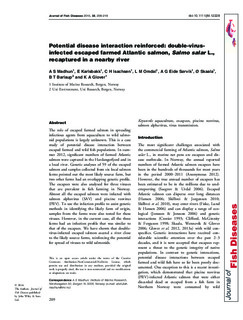| dc.contributor.author | Madhun, Abdullah Sami | |
| dc.contributor.author | Karlsbakk, Egil | |
| dc.contributor.author | Isachsen, Cecilie Helen | |
| dc.contributor.author | Omdal, Linn Maren | |
| dc.contributor.author | Sørvik, Anne Grete Eide | |
| dc.contributor.author | Skaala, Øystein | |
| dc.contributor.author | Barlaup, Bjørn | |
| dc.contributor.author | Glover, Kevin | |
| dc.date.accessioned | 2015-01-19T09:16:34Z | |
| dc.date.accessioned | 2015-05-06T06:15:23Z | |
| dc.date.available | 2015-01-19T09:16:34Z | |
| dc.date.available | 2015-05-06T06:15:23Z | |
| dc.date.issued | 2014-01-27 | |
| dc.identifier.citation | Madhun, A. S., Karlsbakk, E., Isachsen, C. H., Omdal, L. M., Eide Sørvik, A. G., Skaala, Ø., Barlaup, B. T. and Glover, K. A. (2015), Potential disease interaction reinforced: double-virus-infected escaped farmed Atlantic salmon, Salmo salar L., recaptured in a nearby river. Journal of Fish Diseases, 38: 209–219. doi: 10.1111/jfd.12228 | nb_NO |
| dc.identifier.issn | 1365-2761 | |
| dc.identifier.uri | http://hdl.handle.net/11250/283115 | |
| dc.description | - | nb_NO |
| dc.description.abstract | The role of escaped farmed salmon in spreading infectious agents from aquaculture to wild salmonid populations is largely unknown. This is a case study of potential disease interaction between escaped farmed and wild fish populations. In summer 2012, significant numbers of farmed Atlantic salmon were captured in the Hardangerfjord and in a local river. Genetic analyses of 59 of the escaped salmon and samples collected from six local salmon farms pointed out the most likely source farm, but two other farms had an overlapping genetic profile. The escapees were also analysed for three viruses that are prevalent in fish farming in Norway. Almost all the escaped salmon were infected with salmon alphavirus (SAV) and piscine reovirus (PRV). To use the infection profile to assist genetic methods in identifying the likely farm of origin, samples from the farms were also tested for these viruses. However, in the current case, all the three farms had an infection profile that was similar to that of the escapees. We have shown that double-virus-infected escaped salmon ascend a river close to the likely source farms, reinforcing the potential for spread of viruses to wild salmonids. | nb_NO |
| dc.language.iso | eng | nb_NO |
| dc.publisher | Wiley | nb_NO |
| dc.rights | Navngivelse-Ikkekommersiell-IngenBearbeidelse 3.0 Norge | * |
| dc.rights | Navngivelse-Ikkekommersiell-IngenBearbeidelse 3.0 Norge | * |
| dc.rights.uri | http://creativecommons.org/licenses/by-nc-nd/3.0/no/ | * |
| dc.rights.uri | http://creativecommons.org/licenses/by-nc-nd/3.0/no/ | * |
| dc.title | Potential disease interaction reinforced: double-virusinfected escaped farmed Atlantic salmon, Salmo salar L., recaptured in a nearby river | nb_NO |
| dc.type | Journal article | nb_NO |
| dc.type | Peer reviewed | nb_NO |
| dc.date.updated | 2015-01-19T09:16:34Z | |
| dc.subject.nsi | VDP::Agriculture and fishery disciplines: 900::Fisheries science: 920::Fish health: 923 | nb_NO |
| dc.subject.nsi | VDP::Agriculture and fishery disciplines: 900::Fisheries science: 920::Aquaculture: 922 | nb_NO |
| dc.source.pagenumber | 209-219 | nb_NO |
| dc.source.volume | 38 | nb_NO |
| dc.source.journal | Journal of Fish Diseases | nb_NO |
| dc.source.issue | 2 | nb_NO |
| dc.identifier.doi | 10.1111/jfd.12228 | |
| dc.identifier.cristin | 1200543 | |

